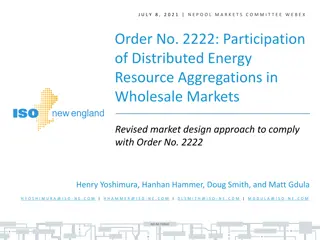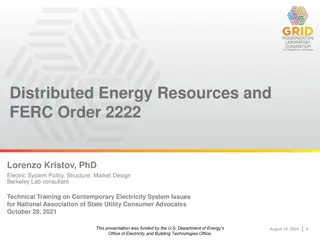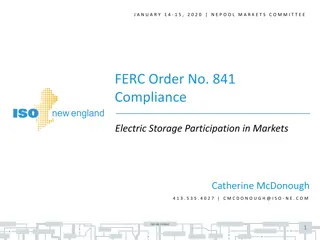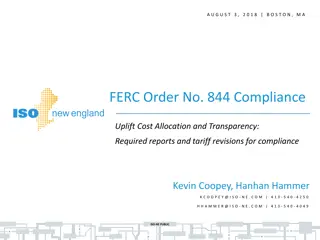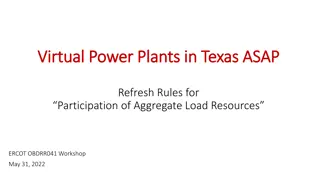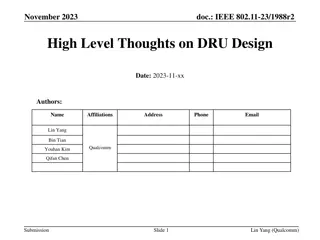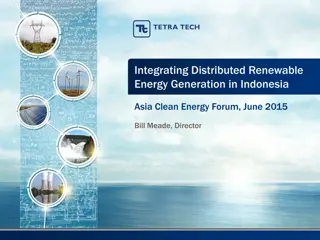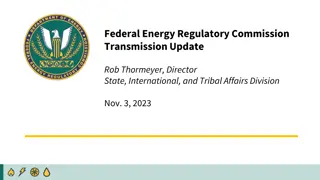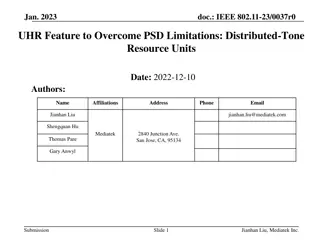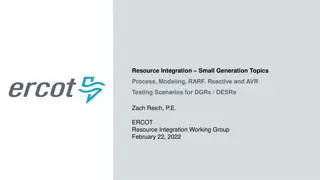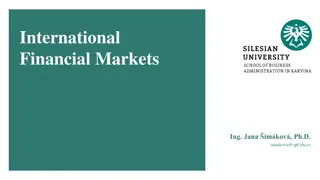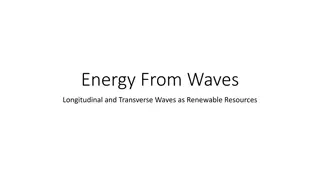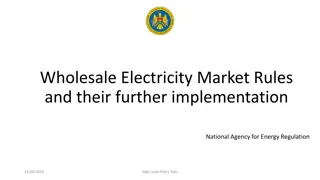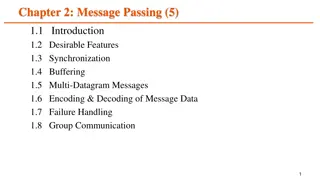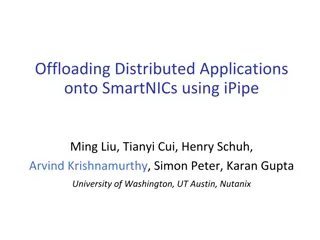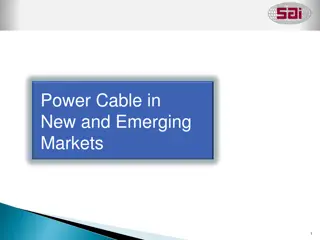Participation of Distributed Energy Resource Aggregations in Wholesale Markets: Compliance with Order No. 2222
The presentation outlines the high-level market design approach by ISO New England to comply with Order No. 2222, allowing distributed energy resources to provide wholesale services. It covers compliance directives, participation models, metering requirements, registration coordination, operational aspects, and next steps for ISOs/RTOs. The background of Order No. 2222 and key compliance directives are discussed, emphasizing the importance of DER participation and regulatory compliance in wholesale markets.
Download Presentation

Please find below an Image/Link to download the presentation.
The content on the website is provided AS IS for your information and personal use only. It may not be sold, licensed, or shared on other websites without obtaining consent from the author. Download presentation by click this link. If you encounter any issues during the download, it is possible that the publisher has removed the file from their server.
E N D
Presentation Transcript
F E B R U A R Y 9 - 1 0 , 2 0 2 1 | W E B E X Order No. 2222: Participation of Distributed Energy Resource Aggregations in Wholesale Markets Draft high-level market design approach to comply with Order No. 2222 ISO New England, Inc. ISO-NE PUBLIC
Participation of Distributed Energy Resource Aggregations in Wholesale Markets WMPP ID: 155 Order No. 2222, issued on September 17, 2020, requires that ISOs/RTOs allow distributed energy resources (DERs) to provide all wholesale services that they are technically capable of providing through an aggregation of resources To comply, ISO/RTOs either need to: Revise their tariffs consistent with specific requirements from the Order, or Point to existing tariff provisions that satisfy the intent and objectives of the Order These slides present the ISO s high-level design approach to comply with Order No. 2222 The ISO is continuing to receive and reflect on feedback from stakeholders, which may result in design modifications and updates that will be shared with stakeholders ISO-NE PUBLIC 2
Presentation Outline Order No. 2222 background and compliance directives DERA Participation Models Metering and Telemetry Requirements DERA Registration Coordination Operational Coordination among ISO, DER Aggregator and Distribution Utility Interconnection and Market Participant Service Agreement Next Steps ISO-NE PUBLIC 3
ORDER NO. 2222 Background and compliance directives ISO-NE PUBLIC ISO-NE PUBLIC 4
Background The FERC issued Order No. 2222 on September 17, 2020 Requires that ISOs/RTOs allow distributed energy resources to provide all services that they are technically capable of providing through [an] aggregation (Id. at P 130) ISO/RTOs must revise their tariffs to be consistent with specific Order requirements, or Demonstrate how current tariff provisions satisfy the intent and objectives of the Order Compliance filings are due on July 19, 2021 Compliance filings must address eleven directives ISO-NE PUBLIC 5
Key compliance directives of Order No. 2222 Order No. 2222 has eleven key compliance directives: 1. Allow distributed energy resource aggregations (DERAs) to participate directly in RTO/ISO markets and establish DER aggregators as a type of market participant Allow DER aggregators to register DERAs under one or more participation models that accommodate the physical and operational characteristics of the DERA Address size requirements for DERAs and individual DERs Address locational requirements for DERAs Address distribution factors and bidding parameters for DERAs Address information and data requirements for DERAs 2. 3. 4. 5. 6. ISO-NE PUBLIC 6
Key compliance directives of Order No. 2222 (cont.) 7. 8. Address metering and telemetry requirements for DERAs Establish market rules on coordination between the RTO/ISO, DER aggregator, distribution utility, and Relevant Electric Retail Regulatory Authorities (RERRAs) Address modifications to the list of DERs in a DERA 10. Address market participation agreements for DER aggregators 11. Implement opt-in provision for distribution companies with 4 million MWh of annual sales 9. ISO-NE PUBLIC 7
ORDER NO. 2222 DERA participation models ISO-NE PUBLIC ISO-NE PUBLIC 8
BACKGROUND Existing participation models ISO-NE PUBLIC ISO-NE PUBLIC 9
The ISO administers five markets and offers eleven participation models The ISO currently administers five wholesale markets: Forward Capacity Market, Forward Reserve Market, Day-Ahead Energy Market, Real-Time Energy Market, and Regulation Market The ISO currently offers eleven participation models: 1. Desired Dispatch Point (DDP) Dispatchable Generator 2. Do-Not-Exceed (DNE) Dispatchable Generator 3. Settlement Only Resource (SOR) 4. Binary Storage Facility (BSF) 5. Continuous Storage Facility (CSF) 6. Alternative Technology Regulation Resource (ATRR) 7. Dispatchable Asset Related Demand (DARD) 8. Load Asset 9. Demand Response Resource (DRR) 10. On-Peak Demand Resource 11. Seasonal Peak Demand Resource ISO-NE PUBLIC 10
Each participation model is governed by a set of rules and associated requirements In general, a participation model encompasses requirements for: Registration, measurement and verification (e.g., metering and telemetry), auditing, offer parameters and bidding processes, mitigation, performance assessment, settlement, etc. A single resource may be allowed to participate in more than one model simultaneously, depending on the capability of the resource and on whether the rules allow for such simultaneous participation e.g., a demand response asset can simultaneously participate as an ATRR In some cases, simultaneous participation is not allowed e.g., to prevent double-counting, a demand response asset cannot simultaneously participate as a generator asset ISO-NE PUBLIC 11
Resources under the existing participation models will be unaffected The ISO does not plan to change the existing participation models with the Order No. 2222 compliance proposal Thousands of MWs of DERs are currently participating in the ISO s markets under the existing models. These DERs will be unaffected by the proposal, for example: Settlement Only Resource (SOR) model for individual DERs less than 5 MW Demand Response Resource (DRR) model for DR aggregations per FERC Order No. 745 On-Peak and Seasonal Peak Demand Resource models for energy efficiency to participate in the Forward Capacity Market Alternative Technology Regulation Resources (ATRR) model for an aggregation of one or more resources providing regulation ISO-NE PUBLIC 12
DERA OVERVIEW Physical and Operational Characteristics ISO-NE PUBLIC ISO-NE PUBLIC 13
DERA physical and operational characteristics In ISO s view, a DERA comprises a wide range of distributed energy resources with different technologies and different use cases at different locations A DERA can: Consist of a single DER or an aggregation of DERs, depending on the size and location of the DERs (details later) Include one technology type or multiple technology types, i.e., heterogeneous aggregation Participate in wholesale markets and retail programs Be dispatchable or settlement-only ISO-NE PUBLIC 14
DERA physical and operational characteristics (cont.) A DERA has: Generation capability if it can inject energy collectively from the constituent DERs Retail Delivery Points (RDPs) and/or Points-of- Interconnection (POIs) Consumption capability if it can withdraw energy collectively from the constituent DERs RDPs and/or POIs Regulation capability if it can provide regulation collectively from the constituent DERs RDPs and/or POIs A DERA s energy injection or withdrawal is settled directly through the Energy Market. Any time a DERA Injects at the RDPs, the net energy injection will be credited at LMP Withdraws at the RDPs, the net energy withdrawal will be charged at LMP Different from a DRR, a DERA does not pay for demand reduction, so it does not need a baseline to calculate demand reduction ISO-NE PUBLIC 15
DERA physical and operational characteristics (cont.) A DERA may include any combination of Front-of-the-meter generators (FTM Gen) Generators directly connected the distribution network at a POI Load behind a POI, as in the case of electric storage Load behind a RDP Load along with behind-the-meter generators (BTM Gen) behind a RDP ISO-NE PUBLIC 16
ISOs approach to prevent double counting It is Load along with BTM Gen not BTM Gen by itself that is counted for settlement This distinction is crucial to comply with the no double counting requirement in the Order It ensures the output from a BTM Gen is not counted as both an increase to supply and a decrease in load For example, a DERA is consuming 3 MW at RDPs, then a BTM Gen is turned on If the BTM Gen outputs 1 MW, the 2 MW load at the RDPs is charged If the BTM Gen outputs 5 MW, the 2 MW supply at the RDPs is credited DER Aggregator is the Load Serving Entity (LSE) for any aggregation that includes load This is consistent with the treatment of load associated with a FTM ESF The ISO proposes that an end-use customer facility cannot simultaneously participate as part of a DRR (existing model) and as part of a DERA (new model) ISO-NE PUBLIC 17
Due to no double counting requirement, the ISO does not recommend sub-metering Some stakeholders have suggested allowing for BTM technology to be metered directly (sub-metering) If sub-metering is allowed, load reconstitution would be required to prevent double counting Load reconstitution is administratively infeasible for the ISO to perform since the needed data will not be provided to the ISO on a routine basis Load reconstitution must be performed on a DER-specific basis DER Aggregators report aggregated data representing the DERA as a whole for settlement; data on individual DERs comprising an aggregation are not reported, but must be retained by DER Aggregators for auditing purposes The ISO is open to considering sub-metering if DER Aggregators, utilities, meter readers, and state regulators work out a viable load reconstitution solution Any DER reconstitution would need to be a part of the Host Participant Meter Reader s load balance calculations within each metering domain ISO-NE PUBLIC 18
NEW MODELS Settlement Only DERA Participation Model Dispatchable DERA Participation Model ISO-NE PUBLIC ISO-NE PUBLIC 19
The ISO proposes two new participation models Existing participation models do not allow aggregations of DERs that inject energy into the system with DERs that withdraw energy from the system To address this gap and ensure all forms of DERA can participate, the ISO proposes two new models Settlement Only DERA (SODERA) participation model If a DER Aggregator registers a SODERA, it may be able to inject and withdraw Dispatchable DERA (DDERA) participation model If a DER Aggregator registers a DDERA, it may be able to inject, withdraw, provide reserves and/or regulate ISO-NE PUBLIC 20
New participation models summary Participation Model Market Products Energy is settled based on LMP May be eligible to provide capacity Market Asset Types Settlement Only DERA DERA SOR + DERA Load Asset Energy is dispatched and settled based on LMPs May be eligible to provide RT reserves and forward reserves DERA Generator Asset + DERA DARD + DERA ATRR Dispatchable DERA May be eligible to provide regulation May be eligible to provide capacity ISO-NE PUBLIC 21
SODERA PARTICIPATION MODEL Eligible to provide capacity and energy ISO-NE PUBLIC ISO-NE PUBLIC 22
SODERA can participate in the Forward Capacity Market SODERA can be a resource participating in the FCM Capacity Supply Obligation will be based on the generation capability of the DERs comprising the SODERA Capacity Load Obligation will be based on the actual consumption of the DERs comprising the SODERA during the peak hour in the previous year The current capacity market rules are being evaluated and may be modified to further accommodate SODERAs ISO-NE PUBLIC 23
SODERA participates as two assets in the Energy Market A SODERA is not dispatched by the ISO is settled by the ISO for energy injected and withdrew must meet proposed revenue quality metering requirements (details later) is not required to meet telemetry requirements is not required to have Designated Entity is not required to submit bids/offers is a RT price taker After a DER Aggregator registers a SODERA, it participates as two assets: 1. DERA SOR represents the generation capability of the SODERA 2. DERA Load Asset represents the consumption capability of the SODERA SODERA is not required to have both generation capability and consumption capability ISO-NE PUBLIC 24
SODERA participates as two assets in the Energy Market (cont.) The main difference between a SODERA and a SOR is that SODERA allows DERs to aggregate, while SOR does not The main difference between a SODERA and a Load Asset is SODERA is settled at the locational price it is mapped to (details later), while a Load Asset is settled at a Load Zone price ISO-NE PUBLIC 25
SODERA can submit DA demand bids, but not provide ancillary services A SODERA can submit fixed or price-sensitive demand bids in the DA market for the load portion of its resource energy generation and consumption is settled at the LMPs A SODERA cannot provide ancillary services because it is not dispatchable and does not provide telemetry to the ISO ISO-NE PUBLIC 26
DDERA PARTICIPATION MODEL Eligible to provide capacity, energy and ancillary services ISO-NE PUBLIC ISO-NE PUBLIC 27
DDERA can participate in the Forward Capacity Market DDERA can be a resource participating in the FCM Capacity Supply Obligation will be based on the generation capability of the DERs comprising the SODERA Capacity Load Obligation will be based on the Nominated Consumption Limit of the DERs comprising the SODERA The current capacity market rules are being evaluated and may be further modified to accommodate DDERAs ISO-NE PUBLIC 28
DDERA participates as three assets in the Energy Market A DDERA is dispatchable by the ISO must meet the Dispatchable Resource definition (see footnote) must meet proposed telemetry requirement and revenue quality metering requirement (details later) must have Designated Entity must submit and manage bids and/or offers After a DER Aggregator registers a DDERA, it can participate as three assets: 1. DERA Generator represents the generation capability of the DDERA 2. DERA DARD represents the consumption capability of the DDERA 3. DERA ATRR represents the regulation capability of the DDERA is capable of receiving and responding to electronic Dispatch Instructions in accordance with the parameters contained in the Resource s Supply Offer, Demand Bid, Demand Reduction Offer or Regulation Service Offer ISO-NE PUBLIC 29
DDERA participates as three assets in the Energy Market (cont.) A DDERA is not required to have all three capabilities For example, if a DDERA only has generation capability, only DERA Generator Asset will participate in the markets; DERA DARD and DERA ATRR will not be applicable This is similar to our current Continuous Storage Facility (CSF) model Once a CSF is registered, it can participate simultaneously as three assets: a Generator Asset, a DARD, and a ATRR ISO-NE PUBLIC 30
Energy Market Bidding Parameters for DDERA In the DA and RT energy market, a DDERA can provide these bidding parameters: Price/MW Quantity pairs Economic Minimum Limit and Economic Maximum Limit to reflect supply-side flexibility Minimum Consumption Limit and Maximum Consumption Limit to reflect demand-side flexibility Ramp rates A DDERA can self-schedule in DA and RT to ensure it is committed to be online in a given hour, or declare unavailable Minimum Run Time, Minimum Down Time, Notification Time, Start-Up Time, Start-Up Fee, and No-Load Fee would be assessed zero values ISO-NE PUBLIC 31
High Level Proposed Energy Market Participation Rules A DDERA can set the DA LMPs and RT LMPs A DDERA is issued a combined dispatch control signal equal to Generator DDP DARD DDP + ATRR AGC SetPoint To be considered to be following dispatch, the sum of the injection/withdrawals at the POIs/RDPs of the constituent DERs shall equal the DDP These rules are similar to the Continuous Storage Facility (CSF) rules ISO-NE PUBLIC 32
A DDERA can participate in wholesale markets and retail programs DDERA can participate in both wholesale markets and retail programs by leveraging ISO s hourly offer capabilities, intra- day reoffers, self-scheduling, self-dispatch, etc. DDERA s participating in both wholesale markets and retail programs are still obligated to follow ISO s Dispatch Instructions If the entire DDERA or a portion of the DDERA is unavailable for ISO s dispatch, the resource s operating limits must be updated to reflect that unavailability ISO-NE PUBLIC 33
A DDERA can participate in wholesale markets and retail programs (cont.) An online DDERA can shape its hourly supply offer to achieve specific Desired Dispatch Points Hourly supply offers can be updated up to 30 minutes prior to the operating hour via eMarket In the event the 30 minute deadline is missed, the resource can use the Self-Dispatch capability which, if granted, enables the resource to be dispatched at its requested MW ISO-NE PUBLIC 34
DDERA can provide ancillary services A DDERA Can be compensated for RT reserves, if eligible Can be compensated for forward reserves, if eligible Can be compensated for regulation capacity and service, if eligible The ISO expects the existing eligibility criteria apply to a DDERA ISO-NE PUBLIC 35
SIZE AND LOCATIONAL REQUIREMENTS 100 kW minimum size for DERA Aggregation across a wide geographic footprint ISO-NE PUBLIC ISO-NE PUBLIC 36
Size Requirements For a DERA: Minimum size is 100 kW No maximum size limit For a DER: No minimum size requirement No maximum size limit for a DER, provided an individual DER with generation capability greater than 5 MW will be its own DDERA A DER > 5 MW cannot be SODERA This rule is consistent with the existing maximum size limit for a Settlement Only Resource and a Demand Response Asset Any DER greater than or equal to 100 kW is allowed to be its own DERA ISO-NE PUBLIC 37
The ISO allows aggregation across a metering domain For a DDERA or a SODERA, all constituent DERs are required to be located within the same metering domain This rule ensures Energy Market is settled accurately Metering domain generally follows a distribution utility s service territory within a single Load Zone Supply and demand within each metering domain must balance to zero for each hour More metering domain information on slide 92 -110 of: https://www.iso-ne.com/static-assets/documents/2020/09/20200914-09-wem101-energy-market-accounting.pdf ISO-NE PUBLIC 38
DDERA is required to be within the same DRR Aggregation Zone For a DDERA, in addition to being within a metering domain, all constituent DERs must be located within the same DRR Aggregation Zone Currently there are 20 DRR Aggregation Zones (map on next slide) DRR Aggregation Zones were defined to be the widest possible geographic area with minimal transmission constraints within the area Requiring all constituent DERs of a DDERA to be within an DRR Aggregation Zone reduces the likelihood that a dispatch of the DDERA will have an unknown impact on a transmission constraint ISO-NE PUBLIC 39
DERA is mapped to a single pricing node In ISO s market software, each DRR Aggregation Zone and Load Zone are represented as a single pricing node A DDERA with DERs at multiple substations will be mapped to a DRR Aggregation Zone (AZ) pricing node DDERA is dispatched and settled at the AZ node LMP A SODERA with DERs at multiple substations will be mapped to a Load Zone (LZ) pricing node SODERA is settled at the LZ node LMP However, an aggregation of DERs at a single substation => 5 MW will be mapped to the substation pricing node (and cannot be aggregated with other DERs) given the concentrated response of the DDERA at that location ISO-NE PUBLIC 41
DER Aggregators are not required to provide distribution factors Since a DERA is a single-node aggregation, DER Aggregators are not required to provide distribution factors per the Order As a practical matter, distribution factors are calculated at the electric nodes, not at pricing nodes, for dispatch and pricing purposes Information on electric nodes are not publicly available so DER Aggregators would not be able to calculate distribution factors for each electric node The ISO calculates distribution factors at the electric nodes based on the historical load patterns For this reason, the ISO does not require distribution factors for demand response resource aggregations The ISO proposes to use the same procedure for DERAs ISO-NE PUBLIC 42
PARTICIPATION MODEL TAKEAWAYS ISO-NE PUBLIC ISO-NE PUBLIC 43
Participation model takeaways The ISO proposes two new models Settlement Only DERA (SODERA) participation model Dispatchable DERA (DDERA) participation model If an aggregation of one or more DERs choose to participate under the new models, it will be referred to as a DERA It is the DERA, not the constituent DERs, that is offered into the markets and dispatched and settled by the ISO The DER Aggregator is the single point of contact with the ISO An aggregation of DERs can still participate using any of the ISO s existing participation models for which they qualify The ISO does not plan to change the existing models ISO-NE PUBLIC 44
ORDER NO. 2222 Metering and Telemetry Requirements ISO-NE PUBLIC ISO-NE PUBLIC 45
Interval metering requirements Interval data representing all Load Assets and Generator Assets participating in the Energy Market are submitted to the ISO by the Assigned Meter Reader daily Since DERAs represent an aggregation of loads and/or generation participating in the Energy Market, we propose: Interval data for each DERA also be submitted to the ISO by the Assigned Meter Reader on the same timetable as that for all other Load Assets and Generator Assets Data submission to the ISO is for the DERA as a whole, not for individual DERs in the DERA Maximum interval length is hourly; 5-minute interval data is optional ISO-NE PUBLIC 46
Interval metering requirements (Cont.) In order to determine the interval data for a DERA, Revenue Quality Metering (RQM) is needed for each DER comprising the DERA RQM must meet existing OP-18 requirements for accuracy and precision RQM data of each DER comprising the DERA must be retained by the DER Aggregator and reported to the ISO upon request for auditing purposes RQM must be located at, or compensated to: Retail Delivery Point (RDP) if DER includes retail load Point of Interconnection (POI) if DER does not include any retail load and is a generator or Electric Storage Facility directly connected to distribution ISO-NE PUBLIC 47
Telemetry requirements Settlement Only DERA (SODERA) Telemetry is not required for a DERA that is registered to be settlement only (SODERA) Only the RQM data for energy injection and withdrawal is required for settlement ISO-NE PUBLIC 48
Telemetry requirements Economically Dispatchable DERA (DDERA) Telemetry data provided to the ISO representing the DDERA is the sum of telemetry from each component DER Telemetry for each component DER is required to be located at or compensated to the RDP or POI OP-18 requirements for DARDS, ATRRs, and Generators would apply to DDERAs Telemetry latency for DDERA depend on market participation choices Energy, Capacity, and thirty-minute reserves only Energy, Capacity, thirty-minute reserves, ten-minute reserves, and/or regulation ISO-NE PUBLIC 49
Telemetry requirements DDERA (Cont.) If DDERA is providing only capacity, energy, and TMOR: Telemetry data is the average energy injection and withdrawal for the DERA in each 5 minute interval Telemetry data must be received by the ISO within 5 minutes of the end of each interval Telemetry data will include at a minimum MW and MVAR If DDERA is providing ten minute reserves and/or regulation in addition to capacity, energy, and TMOR: Telemetry data is instantaneous rate of injection or withdrawal Telemetry data must be updated every 10 seconds (4 seconds if providing regulation) Telemetry data will include at a minimum MW and MVAR ISO-NE PUBLIC 50


